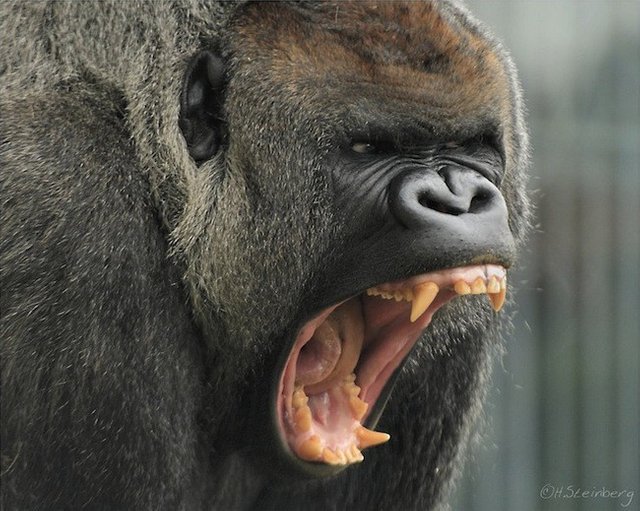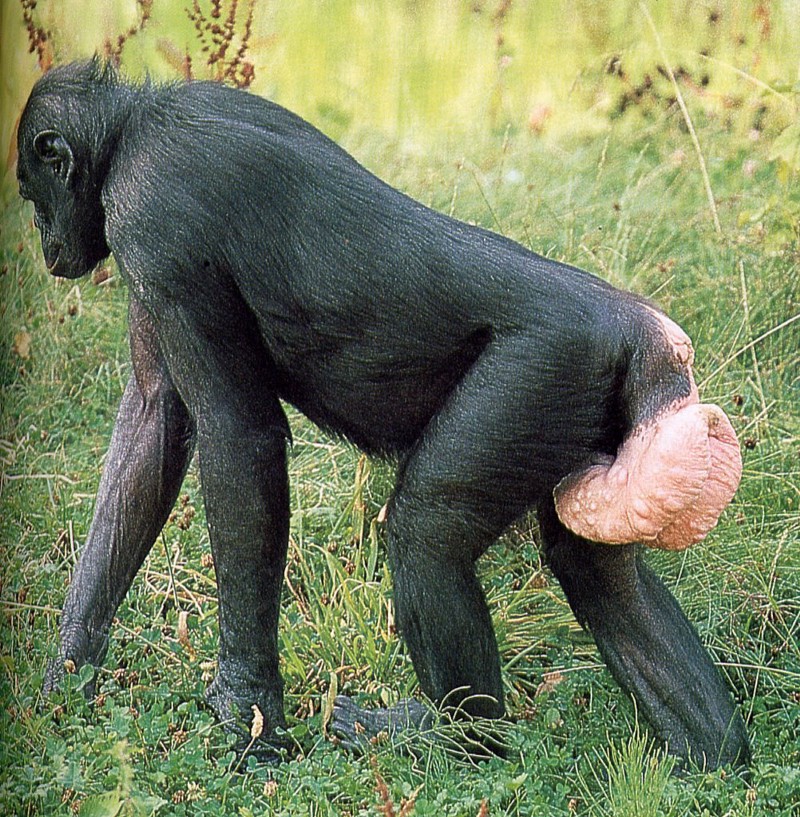
Infidelity is certainly a trait exhibited by humans and it is very common to hear the argument that, for men, it makes sense genetically to sleep with as many women as possible, father as many children as possible, and therefore guarantee the success of their genes. This argument is often supported by looking at our chimpanzee cousins who fight fiercely over females with the aim of impregnating as many as possible. As is often the case with mainstream theories however, this is extremely over-simplified. For one, you cannot look at our chimpanzee cousins for one behaviour (i.e. mating) but ignore their wildly different behaviour when it comes to things like infanticide or their extreme aggression. Perhaps people will say that we don’t exhibit those traits because we are civilised. Perhaps, but I will show you that there are many other reasons we can’t be compared to chimpanzees, and why our unique evolutionary trajectory may imply that we are largely monogamous by nature.
Ancient fossil clues
A huge clue for human monogamy came in the form of Ardipithecus ramidus, a human ancestor that existed around 4 million years ago and whose fossils were first discovered in the 1994.
Until this discovery, it was largely assumed that humans evolved to walk on two legs from apes. Ardipithecus however showed that humans were already well-adpated to bipedality (walking on two legs) while maintaining abilities to maneuver around trees. This showed that both apes and humans evolved different walking techniques after the split from the last common ancestor (apes evolved knuckle-walking and humans evolved to walk on two legs). It’s teeth showed it was a generalised omnivore and was lacking what is known as the “sectorial canine complex” (SCC). This is a large tooth present in apes to that is the cardinal indicator of male-to-male competition in primates.

Teeth, sperm and monogamy
The lack of the SCC is important as it suggents humans have lacked the male-to-male aggressive behaviour prevalent in many apes since at least 4 million years ago, close to the split of the last common human/chimpanzee ancestor.
Some people have argued that this the SCC was merely lost due to replaced aggression using weapons between males. However, the reduction of the SCC long pre-dates the invention of weapons. Additionally, if male-to-male fighting was key in our evolution, we would have other evolutionary traits.
For example, sperm competition for example is absent in humans and some other primates such as gorillas and orangutans. These primates exhibit very small testicular size with low sperm quality. Chimpanzees on the other hand have large testicles and a higher sperm count indicating sperm competition. (I have written an article on sperm competition and testicular size here). Human testicles are somewhere in between, but have some of the lowest sperm quality and lack other indicators of sperm competition (coagulating sperm for example). However, the testicles in humans are more pendulous even than chimpanzees, whereas gorillas and orangutans have lost a free-hanging scrotum and have the testicles more protected. In the case of male-to-male aggression using weapons (and on two legs), it would be expected that the testicles would be more protected. The lack of sperm competition itself also indicates a monogamous lifestyle (albeit with some infidelity).
How walking on two legs could have led to monogamy
Another unique feature of humans is bipedalism, or, walking on two legs. As our ancestors began coming down from the trees they would have found that terrestrial resources are a lot more defensible. In chimpanzees and gorillas, this has led to increased male-to-male aggression since they guard their territories, but the lack of SCC in hominids indicates that they did not engage in territorial defense to the same scale. According to a review by Owen Lovejoy, an advantage of walking on two legs is that resources could be carried over large areas, or acquired from areas that do not need to be defended and moved to a more defensible position. Walking on two legs also allows the use of rudimentary tools for resource exploitation such as extracting difficult to reach fruit or roots. It is tempting to say that tools drove the evolution of bipedalism, but it is now known that bipedalism existed long before the invention of tools.
Given the ecological context of early hominids, it is very likely that females engaged in a food-for-mating strategy, much like other apes do. Important foods such as fruit high in fat or meat would be very valuable, and often too difficult for females with dependent infants to acquire in large areas where resources are scarce. A pair bond with a male who would acquire these resources and bring them back would be very advantageous in this situation.
This is not only advantageous for the female but for the male. While females and the offspring enjoy reduced predation risks, males benefit from the intense mothering of their offspring, leading to a higher chance of offspring survival. This would lead to females choosing provisioning males over aggressive males due to the enhanced fitness benefits. This theory is supported by more evidence as we’ll see below.
What conditions does monogamy need to evolve?
Less than 5% of mammals are monogamous, so what demands must be met for monogamy to evolve? It appears that ecological demands such as patchy resource distribution, a low population density of females and increased predation risks lead to monogamous pair bonding because males are required to contribute to offspring care in order to safeguard their investment in reproduction.
It seems ancient humans would have experienced all of this due to their ecological context, and females became increasingly rare as birth spacing was prolonged. There seem to be three main solutions to these problems:
Males cooperate with kin to expand their territories and gain access to reproductive females (chimpanzees)
Males displace other males, even if related, to optimise male:female ratios (gorillas)
Males provide food in exchange for mating, leading to female preference for non-aggressive provisioning males for repeated copulation (humans)
In the first two options, the SCC is under positive selection for increased size, while in the last option the SCC is under negative selection to demonstrate a lack of aggressiveness as females are choosing a male that provides rather than dominates.
Mathematical models have also shown that a population can switch from promiscuous to monogamous in these situations. Initially low-ranked males will begin providing for females, as an alternative strategy when they can’t compete with high-ranked dominant males. As females begin to prefer being provisioned for, this strategy moves up the ranks until most males, except the highest-ranking ones, are providing for females. Simultaneously, females are evolving fidelity as a means to maintain the provision. There are fluctuations in this, because when most males are providing, faithfulness is not selected for anymore and females begin exploiting the system by breeding with higher-ranked males while being provided for by lower ranks, which in begins to select for more aggressive males. This leads to a variation in male strength throughout the population. However, it has been shown that when the fitness benefits of promiscuity are not too large, and the variation in male strengths is significant (as happens when the system fluctuates), the population shifts back to a pair-bonding state with high female fidelity and high male provisioning.
Concealed ovulation
An interesting question is, if scenario 3 above is correct, why did hominid females not advertise their ovulatory period like other apes do, in order to increase sex-for-food exchanges?

First lets look at this. A male that provides habitually for a female, even while pregnant, will most likely be the father of any future offspring once the female begins ovulation again. A frequent argument against scenario 3 , is the problem of cuckoldry while the male is absent. However, ovulation is hominoids is rare, and male provisioning of fertile females (even if rarely ovulating) increases his fitness because a) regular intercourse increases the likelihood of him being the father of any offspring and b) frequent providing of food reinstates ovulation quicker by replenishing fat stores.
The female can assure the male there is no cuckoldry by concealing ovulation. That means ovulation would not be advertised for more dominant males to know and attempt to copulate. This happens in the form of enlarged mammary glands to hide swelling during ovulation and a lack of any olfactory signals to name a few. This increases fitness for the female who can assure the male the children she bears are his, therefore encouraging the male to increase investment in provisioning food for her and the offspring.
Mathematical support
The behaviour of early humans is difficult to investigate, especially when the only clues we have are physical ones in the forms of fossils. Thankfully, mathematical models have been developed which can be used to investigate whether certain traits are likely to evolve or not. Despite the evidence I have given, there are many people who would still argue that humans are not naturally monogamous. Mathematical models however have indeed shown that monogamy is a stable trait that could have evolved in humans under these conditions.
The main problem males face in switching from promiscuity to pair-bonding is that switching from competing with males to providing for females would give advantages to free-riding competitors. If I am the only male providing for a female, I will be exploited by other males who will “steal” paternity (i.e. I will father their children).
However this dilemma is solved under certain conditions. There are more low-ranked males than elite males and therefore selection benefiting the “masses” becomes stronger. In this sense, low-ranked males have more to gain by providing for females and as a response, females simultaneously evolve faithfulness and these two coevolve in a self-reinforcing manner, as the fitness of both males and females is increased. Except for a very few high-ranking males, all males invest their energy in female provisioning. Females are not expected to remain 100% faithful, but will be controlled by a balance between selection for better genes and better access for food and care.
So what does this say about today?
It would be wrong to extrapolate this too far into modern society. In modern society, many traits are a result of nurture rather than nature. Infidelity is an aspect of human behaviour, but overall, human societies are monogamous. A lot of people will argue that religion caused this and people are naturally promiscuous. This research seems to indicate that humans have long exploited the advantages given by working as a male-female team where female fidelity is important for persuading the male to provide resources as this increases his fitness, since the children she bears will be his, and her fitness, since she has access to important resources and can focus more on providing for offspring.
However, whether this was a life-long bond or not, it is not known. Deciphering biological and societal causes can be difficult. However, what does seem to be true, is that humans naturally lean towards monogamy and pair-bonding and it is wrong to compare us to the mating behaviours of other primates without looking into our past.
Find more of my science blogging, such as this article and more, on Medium.
Hi! I am a robot. I just upvoted you! I found similar content that readers might be interested in:
https://medium.com/@mikrobiologia/are-humans-naturally-monogamous-or-polygamous-ef7bfd1d357
Downvoting a post can decrease pending rewards and make it less visible. Common reasons:
Submit
Thanks cheetah, that is in fact, the same article on a different platform. I thought people on steemit might enjoy the writing also. I have been previously verified by steemit as the original author on both accounts.
Downvoting a post can decrease pending rewards and make it less visible. Common reasons:
Submit
Vote for vote and flow me i will flow you
Downvoting a post can decrease pending rewards and make it less visible. Common reasons:
Submit
Hi mdgazi, thank you for the comment. However I'm more interested in using the site by voting for things I enjoy or find relevant for other users and I see this as spamming.
Downvoting a post can decrease pending rewards and make it less visible. Common reasons:
Submit
Congratulations @dedalux13! You received a personal award!
You can view your badges on your Steem Board and compare to others on the Steem Ranking
Vote for @Steemitboard as a witness to get one more award and increased upvotes!
Downvoting a post can decrease pending rewards and make it less visible. Common reasons:
Submit